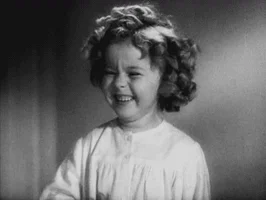Stair Dance- Little Colonel, 1935- Bill "Bojangles" Robinson and Shirley Temple
This dance is one of the most important in the history of film. How often do I get to say that?
It marked the first on-screen interracial dance.
"The Little Colonel" was the first movie in a line of films that featured both Shirley Temple and Bill "Bojangles" Robinson.
 Yup. That Bojangles, like the song (not the restaurant... I don't think? That would be weird).
Yup. That Bojangles, like the song (not the restaurant... I don't think? That would be weird)."Bojangles" is one of the most famous American dancers ever and completely revolutionized the art of tap dancing.
but first some...
Dance Background:
There are several different forms of tap. They all basically spring from the original form which is now dubbed "Rhythm Tap." Rhythm Tap came primarily from older African-American dance forms and was an almost entirely black dance style. It is highly rhythmic (as the name implies) and was a big part of the development of the swing music style. I will get into that in a separate post.
Rhythm tap became a popular form of Vaudeville entertainment for black audiences. White audiences also took to it and soon white dancers began trying to copy the moves.
Bill "Bojangles" Robinson revolutionized tap by bringing it up onto its toes instead of the more traditional flat-footed style. Many dancers of his time and after (Fred Astaire, Gene Kelly, etc.) said that they were inspired by Bill Robinson.
He was known on Vaudeville for his incredible stair dance.
At the time black dancers were looked over for anything Hollywood and it is a mark of just how popular Bill Robinson was that Hollywood felt it would be profitable (even given the primarily white audience that they were catering to, the segregation, anti- African American laws, and general societally lauded racism of the time) to put him in films with their biggest banking star at the time, Shirley Temple.
To give you an idea of Hollywood casting racism of the time it is worth noting that this film came out the same year as Top Hat (1935). Fred Astaire was 36 and Top Hat was only his 5th film, ever. Bill Robinson was 58 and had been dancing for far longer than Astaire. In fact, Fred Astaire referenced Bojangles as being one of his dance inspirations. Astaire was playing only leads, Bojangles was barely allowed to play a butler and him dancing with a white girl (even a 6-year-old) was practically scandalous at the time.
Temple was six years old when this film was made and already famous for her singing and acting talents. This movie brought her dancing skills to the forefront. "The Little Colonel" was an important step (hah!) to Shirley Temple reaching her peak of fame.
And in all honesty, she deserves it! Robinson was an excellent teacher and she was clearly a great study.
Bojangles and Shirley Temple became long-time friends thanks to their film partnerships. She called him "Uncle Billy" and often spoke of his wonderful dance instruction methods and his kind personality. He taught her to dance from sound, not by watching his feet. He is quoted as saying "Now let's get your feet attached to your ears" when he began teaching her.
Theirs is a truly unlikely friendship, both because of the age gap and because of the sheer level of racism at the time. Shirley Temple, for her part, had very little idea why her good friend was treated so shockingly differently from herself. According to Shirley Temple in her autobiography, Bill Robinson did his best to maintain her innocence on the subject.
The Dance
O.K., on from the history to the dance itself. The film is set in the Civil War and is a classic Shirley Temple vehicle; She has to break through the curmudgeon exterior of the old man of the house, who looks weirdly like the Kentucky Fried Chicken guy. Bill "Bojangles" Robinson plays the family butler (which was about the only thing that 1935 Hollywood would hear of a black man playing in a movie with a mostly white cast).
As far as I can find out, "Bojangles" choreographed the dance himself, which is hardly surprising. He was famous for dancing on stairs, and you can see why; adding the stairs to this scene is like adding an extra set of drums to an already fabulous drum solo.
I can't tell if there is sand at the top of the stairs. However, "sand dances" were still somewhat in style. In a sand dance, you would sprinkle the floor with sand and it would create a distinctive soft sound with the taps.
Enjoy!






Comments
Post a Comment